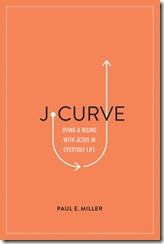 Those who have had to listen to my preaching a bit will know that I have a couple of hobby horses. Partly because I think they are under-taught I will tend to major on the themes of union with Christ and strength in weakness. What I have not been good at is bringing those two themes together. However, Paul Miller has done it in his fascinating book J-curve. His argument, which he pursues with a mixture of Bible, example from church history and personal testimony, is that our union with Jesus brings us into an experience of his death and resurrection. Hence, the Christian will have to go down (the first bit of the J) before experiencing uplift- the resurrection part.
Those who have had to listen to my preaching a bit will know that I have a couple of hobby horses. Partly because I think they are under-taught I will tend to major on the themes of union with Christ and strength in weakness. What I have not been good at is bringing those two themes together. However, Paul Miller has done it in his fascinating book J-curve. His argument, which he pursues with a mixture of Bible, example from church history and personal testimony, is that our union with Jesus brings us into an experience of his death and resurrection. Hence, the Christian will have to go down (the first bit of the J) before experiencing uplift- the resurrection part.
That may not be a new thought. But what Miller does superbly is use it as a way of framing the whole Christian life. There is no shortage of biblical material to cover. It is the very nature of discipleship in Mark’s Gospel- Christians follow Jesus to his death as we take up our cross but then discover that this giving away of our lives is the way to gain them (Mark 8:34). In John’s Gospel Jesus, speaking of both himself and his followers, teaches that it is the seed that goes into the ground and dies that produces a harvest of life (John 12). And then it becomes a massive theme within Paul’s writings. In Galatians 2 it is no longer I who live (because I have been crucified with Christ) but Christ who lives in me. In Romans 6 I am united with Christ in his death and resurrection through baptism. And in 2 Corinthians 4 (as we considered recently) Paul’s ministry is shaped by carrying around the death of Jesus so that the life of Jesus may be revealed in him and, in due course, others as well. The normal Christian life features death and resurrection in our union with Christ.
This reality is both instantaneous at conversion and ongoing throughout life. Being justified as I trust in Jesus is a death to trusting in myself, the old self is gone and I am a new creation joined to the risen Jesus. But Miller is at his most interesting as he talks about the daily experience of death and resurrection. He talks about it in three areas: suffering, repentance and love. Suffering inevitably has a downward sense of death about it. Yet the whole New Testament insists that, if that is met with trust in the Lord, then great good in our lives and others can come through it even in the midst of tears. There is always a death in repentance. It is a question of killing off some sin to which we have been clinging or looking for pleasure or escape. That is painful- there is an inevitable short-term “down” to that. Yet it is the path to life as we ultimately discover that a sense of being close to the Lord- at whose right hand our pleasures forevermore- is better. And, contrary to what is imagined, there is a real death in genuine love. The best description I have heard of love is walking towards the pain. Sometimes that is experiencing brief inconvenience for the sake of others; on other occasions, it is immersing yourself deeply in their agony. I’ve spent time talking through my own personal pains and listening to those of others. The latter is often costly and draining and yet it is worth it because I know from doing the former the benefit it brings. Love brings life to others- and perhaps we can ultimately share in that joy. For Jesus, life was about walking towards death- a great act of love, choosing to obey the Father rather than pursuing the temporary comfort of sin and facing up to the agony of suffering. The result was resurrection. As those united with Jesus we should expect the same road, being aware that He is accompanying us on the journey.
Seeing life through this lens does help us to understand it. It becomes both deeply challenging and encouraging.
It is challenging in that the Christian must expect death and even embrace death. We live in a culture that prizes comfort and goes to astonishing lengths to remove any danger of people experiencing pain and distress. Against that backdrop, the Christian is called to the way of the cross. That will mean that the Christian will not be surprised by opposition to the Gospel, disappointments and weariness in ministry as well as all the physical and emotional agonies of life in a fallen world. The question will be whether we accept these things (even through tears) as part of the deal here and now. And when it comes to repentance and love, the issue is whether we will sacrifice short-term comfort in order to gain long-term joy. Dying with Jesus is the only path to resurrection fruit. I remember a challenging quite from John Stott- the greatest limit to our effectiveness is our tendency to run from our own deaths. Serving the Lord is about carrying in our body the death of Jesus.
And yet- it would be wrong to suggest this is just challenging. Miller notes that whenever he presents this material to those going through a tough time, they inevitably brighten up. That’s no surprise. In the midst of death brought to us through suffering, repentance or love it is easy to think that the only reality will be pain. And yet the pattern of Jesus teaches us that a resurrection will come. Sometimes that happens in the short-term. I am deeply grateful to the Lord that in the mini-deaths that I have experienced there has often been quite a rapid sense of good coming from them in terms of a fresh reliance on the Lord or a greater ability (or smaller inability) to help others. For others, though, I am aware that will only be evident in the new creation. The key point, though, is that whatever the timescale resurrection will ultimately come. That cheers the saddened heart.
This is the normal Christian life. We always carry around in our bodies the death of Jesus so that His life might be revealed.


0 Comments